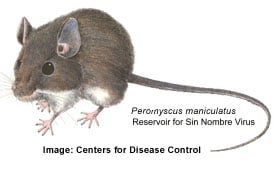BALTIMORE, Md., Dec. 5 -- Satellite imagery could be used to determine areas at high risk for exposure to Sin Nombre virus (SNV), a rodent-born disease that causes the often fatal hantaviral pulmonary syndrome (HPS, or hantavirus) in humans, according to researchers from the Johns Hopkins Bloomberg School of Public Health and other institutions.
The researchers say satellite imaging detects the distinct environmental conditions that may serve as a refuge for the disease-carrying deer mice. Higher populations of infected deer mice increase the risk of HPS to humans. Their findings are published in "Satellite Imagery Characterizes Local Animal Reservoir Populations of Sin Nombre Virus in Southwestern United States," which appears in the Dec. 2 Proceedings of the National Academy of Sciences.
 Gregory E. Glass, Ph.D., professor of molecular microbiology and immunology in the Johns Hopkins Bloomberg School of Public Health, said, "This is an important finding because, at a practical level, it provides a way to monitor the environment for the risk of an infectious disease before an outbreak occurs. At a more basic level, it gives us a way to better understand why outbreaks happen when and where they happen."
Gregory E. Glass, Ph.D., professor of molecular microbiology and immunology in the Johns Hopkins Bloomberg School of Public Health, said, "This is an important finding because, at a practical level, it provides a way to monitor the environment for the risk of an infectious disease before an outbreak occurs. At a more basic level, it gives us a way to better understand why outbreaks happen when and where they happen."
Before satellite imaging was used to predict high-risk areas, the only SNV tracking method was rodent sampling or follow-up to human cases of disease. Johns Hopkins Bloomberg School of Public Health researchers used Landsat Thematic Mapper satellite data from 1997 and 1998 to identify environments associated with human risk of HPS caused by rodent SNV. LANDSAT 5 imagery was obtained for a study area in the southwestern US, where HPS was initially recognized in 1993. The images were processed and HPS risk maps were generated. Logistic regression was used to estimate risk using the digital numbers in each of the three TM bands.
The researchers teamed with workers from the University of New Mexico, the Centers for Disease Control and Prevention and the IBM T.J. Watson Research Center to validate the analysis. Field and laboratory studies of collected rodents were performed in 1998 and 1999. The sample consisted of 15,042 rodents. Researchers tested the deer mice for SNV and then compared their findings to their satellite projected images.
The prevalence of SNV infection in deer mouse populations varied among sites. Researchers found that high-risk sites were ecologically distinct from low-risk sites and SNV infection was prevalent among deer mice in high-risk areas. Woody plants, such as Ponderosa pine and Pinon pine, dominated high-risk sites. Low-risk sites usually contained snakeweed, saltbush, Creosote bush, sagebrush, tumbleweed and mesquite.
Future studies could characterize the ecological dynamics of local environmental conditions and monitor SNV transmission in deer mouse populations and then compare these sites with lower-risk locations.
"The sites may provide important insights into identifying the environmental conditions that lead to increased levels of SNV in reservoir populations and the subsequent increased risk of human disease," Glass said.
For more information, visit: www.jhsph.edu